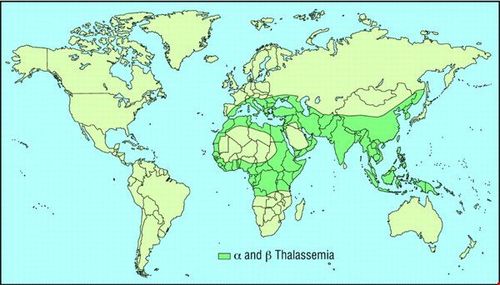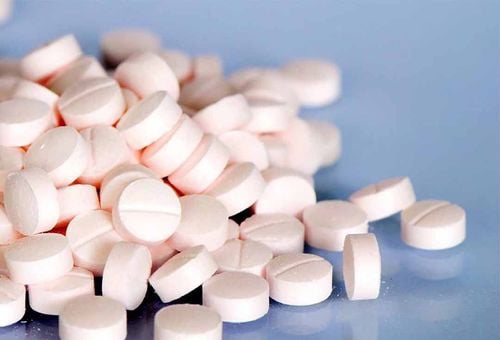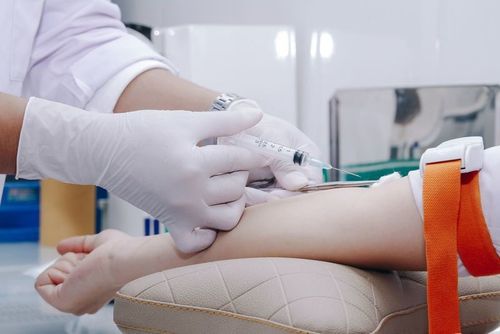This is an automatically translated article.
The article is expertly consulted by Master, Doctor Nguyen Minh Tuan - Pediatrician - Pediatrics - Neonatology - Vinmec Danang International General Hospital. Doctor Tuan has over 27 years of experience in the field of Pediatrics and used to be the Deputy Department of General Pediatrics - Da Nang Obstetrics and Gynecology Hospital. Her strengths are in treating immunological diseases, allergies in children, consulting on urological, neurological, hematological, and endocrine diseases in children.And resident doctor Duong Van Sy - Department of Pediatrics - Neonatology - Vinmec Hai Phong International General Hospital.
Hemolytic anemia in children (also known as Thalassemia) is an inherited hemolytic anemia or congenital hemolytic anemia. This is one of the most common genetic abnormalities today in the world.
1. Hemolytic anemia in infants
Hemolytic anemia in children (also known as Thalassemia) is an inherited hemolytic anemia or congenital hemolytic anemia. A typical sign of the disease is anemia. Thalassemia in children is currently one of the most common genetic abnormalities in the world. Currently, it is estimated that about 7% of people globally are carriers of the gene for hemolytic disease and about 1.1% of couples at risk of becoming pregnant have a baby with the disease or carrying the gene.The disease can be found anywhere in the world, however, the prevalence is higher in the Mediterranean region, the Middle East, and the Asia-Pacific region. In which, Vietnam is one of the countries with high rates of disease and disease genes. Specifically, in our country, the proportion of people carrying the disease gene in the Kinh ethnic group is about 2-4%, while for ethnic minorities living in mountainous areas, this rate increases very high: about 22% with The Muong ethnic group and over 40% with the Ede, Tay, Thai, Stieng...
Thalassemia in children has 2 main types: α(alpha) Thalassemia - Lack of α (alpha) and β (beta) chains. Thalassemia - Deficiency of β(beta) chain
There are 3 levels corresponding to 3 clinical forms:
Severe. Intermediate. Light. In our country, the number of patients with severe congenital hemolysis requiring regular treatment is over 20,000, but only about 5,000 patients have access to treatment. In addition, every year, about 2,000 babies are born carrying the disease gene.

2. Manifestations of thalassemia in children
Thalassemia in children leads to anemia, so the heart of the child has to work harder, causing bone hypertrophy, causing the patient to have features such as a flat, flat nose, protruding forehead, high cheekbones. .Besides, because there is not enough blood to feed the glands, the glands cannot develop fully. The disease called Thalassemia has claimed the lives of many fates, many unfortunate lives. At the same time, the sequelae of this disease are still a pain for patients and the medical community. In addition, parents can identify symptoms according to the severity of the disease.
2.1. Severity
Severe hemolytic anemia in newborns will show severe anemia, even, can be seen right after the baby is born, usually manifests most clearly when the baby is 4-6 months old. and getting heavier and heavier. Common signs of illness are: The child is pale, the skin and sclera of the eyes become yellow, often slower in physical development than children of the same age, may often have fever, diarrhea or other digestive disorders.With adequate and continuous blood transfusion, children with thalassemia can still develop normally until about 10 years of age. After 10 years of age, children begin to face complications due to increased red blood cells and excessive iron accumulation in the body such as:
Bone deformities: The skull is larger, the forehead hump appears, the top of the head is raised. , high cheekbones, flat nose, protruding upper front teeth, osteoporosis, making children very susceptible to fractures. Dull, dull skin, yellow sclera. Delayed puberty: Female up to 15 years old but still not menstruating. Physical retardation Beyond the age of 20, the patient began to appear more complications of heart failure, arrhythmia, diabetes, cirrhosis of the liver,...
2.2. Average level
For infants with moderate hemolytic anemia, anemia usually appears later than severe. It is not until the age of 4-6 years that a child needs a blood transfusion. However, if the child is not treated promptly and fully, complications can still occur such as enlarged spleen, enlarged liver, gallstones, darkening of the skin.By middle age, patients will gradually show symptoms of diabetes, heart failure, cirrhosis of the liver. To overcome this, the patient needs to receive a full blood transfusion and iron chelation, so that he or she can develop normally and without complications.
2.3. Mild (also called carrier)
Thalassemia in children at mild level stops at carrying the disease gene and usually has no special clinical manifestations. Only when the body is in periods of increased blood demand such as women during pregnancy, heavy menstrual bleeding, etc., will they notice signs of fatigue and pale skin.Most cases of thalassemia in children are detected and treated at a late stage. The reason is that parents do not fully understand the disease, or because of difficult or inconvenient family circumstances, they cannot give their children a blood transfusion.
To protect children from agents that affect their health, you need to monitor and take them to a doctor when they have abnormal symptoms.
As a key area of Vinmec Health system, Pediatrics Department always brings satisfaction to customers and is highly appreciated by industry experts with:
Gathering a team of top doctors and nurses in Pediatrics : consists of leading experts with high professional qualifications (professors, associate professors, doctorates, masters), experienced, worked at major hospitals such as Bach Mai, 108.. Doctors All doctors are well-trained, professional, conscientious, knowledgeable about young psychology. In addition to domestic pediatric specialists, the Department of Pediatrics also has the participation of foreign experts (Japan, Singapore, Australia, USA) who are always pioneers in applying the latest and most effective treatment regimens. . Comprehensive services: In the field of Pediatrics, Vinmec provides a series of continuous medical examination and treatment services from Newborn to Pediatric and Vaccine,... according to international standards to help parents take care of their baby's health from birth to childhood. from birth to adulthood Specialized techniques: Vinmec has successfully deployed many specialized techniques to make the treatment of difficult diseases in Pediatrics more effective: neurosurgery - skull surgery, stem cell transplantation. blood in cancer treatment. Professional care: In addition to understanding children's psychology, Vinmec also pays special attention to the children's play space, helping them to have fun and get used to the hospital's environment, cooperate in treatment, improve the efficiency of medical treatment.
Please dial HOTLINE for more information or register for an appointment HERE. Download MyVinmec app to make appointments faster and to manage your bookings easily.














